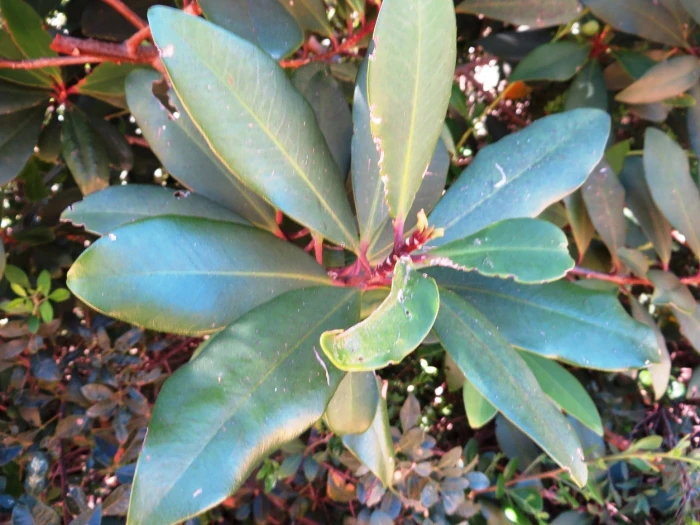Cape Beech
(Myrsine melanophloeos)
Cape Beech (Myrsine melanophloeos)
/
/

linkie
CC BY 4.0
Image By:
linkie
Recorded By:
Copyright:
CC BY 4.0
Copyright Notice:
Photo by: linkie | License Type: CC BY 4.0 | License URL: http://creativecommons.org/licenses/by/4.0/ | Rights Holder: linkie | Publisher: iNaturalist | Date Created: 2018-12-30T10:55:48-08:00 |

























Estimated Native Range
Climate Requirements for Westminster, California
| This Plant | Your Site | Plant Suitability for Your Location | ||
|---|---|---|---|---|
| • Precipitation | 11" - 137" | 13" | Your precipitation may be insufficient for this plant. Irrigate N" / year. | Irrigate N" / year |
| • High Temp. | 40°F - 93°F | 83°F | Your summer temperatures are normal for this plant. | Excellent |
| • Low Temp. | 14°F - 70°F | 45°F | Your winter temperatures are normal for this plant | Excellent |
This plant should grow well at your location with about N inches per year (Y minutes per month) of irrigation.
Summary
Myrsine melanophloeos, commonly known as Cape Beech, is an evergreen tree or large shrub native to the afromontane forests of Africa, spanning from Nigeria and Sudan to South Africa. It is typically found in high-altitude forests, thriving in well-drained, loamy soils. Cape Beech can reach heights of 10 to 15 meters with a similar spread, and it features a dense, rounded crown. The leaves are glossy, dark green, and may exhibit purple or maroon tinges on the stalks and midribs, particularly when young. The tree is dioecious, with separate male and female plants. Small, inconspicuous white flowers give way to tiny dark purple berries that are attractive to birds.
Cape Beech is valued for its dense foliage and robust nature, making it an excellent choice for windbreaks, privacy screens, and coastal plantings where it can tolerate salt spray. It is also used for its ornamental qualities in gardens and urban landscapes. This species prefers full sun to partial shade and requires moderate watering, adapting well to a variety of soil conditions, though it thrives in well-drained, fertile soils. While it is hardy and generally low-maintenance, it can be susceptible to root rot in poorly drained soils. The wood of Cape Beech is strong and has been historically used for furniture and musical instruments such as violins.CC BY-SA 4.0
Cape Beech is valued for its dense foliage and robust nature, making it an excellent choice for windbreaks, privacy screens, and coastal plantings where it can tolerate salt spray. It is also used for its ornamental qualities in gardens and urban landscapes. This species prefers full sun to partial shade and requires moderate watering, adapting well to a variety of soil conditions, though it thrives in well-drained, fertile soils. While it is hardy and generally low-maintenance, it can be susceptible to root rot in poorly drained soils. The wood of Cape Beech is strong and has been historically used for furniture and musical instruments such as violins.CC BY-SA 4.0
Plant Description
- Plant Type: Shrub, Tree
- Height: 7-13 feet
- Width: 10-20 feet
- Growth Rate: Moderate
- Flower Color: Green
- Flowering Season: Spring, Summer
- Leaf Retention: Evergreen
Growth Requirements
- Sun: Full Sun, Part Shade
- Water: Medium
- Drainage: Medium, Fast
Common Uses
Bird Garden, Hedges, Low Maintenance
Natural Habitat
Native to high-altitude forests in Africa, thriving in well-drained, loamy soils
Other Names
Common Names: Cape Myrtle, Tormentil, Black Myrsine
Scientific Names: Myrsine melanophloeos, Chrysophyllum melanophoeos, Chrysophyllum millerianum, Heeria melanophloeos, Manglilla melanophloeos, Manglilla venulosa, Myrsine melanophloeos, Myrsine neurophylla, Myrsine pentandra
GBIF Accepted Name: Myrsine melanophloeos